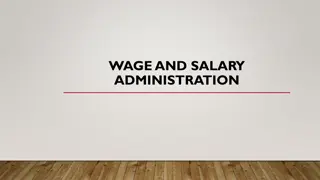Wage Remuneration Methods Overview
Dr. B. N. Shinde, Assistant Professor at Deogiri College, Aurangabad, presents an insightful overview of methods of wage remuneration including Time Rate System, Piece Rate System, and Combination of Time and Piece Rate System. Time Rate System is the oldest method where workers are paid based on time spent, while Piece Rate System pays based on output. Each method has its advantages and disadvantages, influencing workers' productivity and management approaches.
Download Presentation

Please find below an Image/Link to download the presentation.
The content on the website is provided AS IS for your information and personal use only. It may not be sold, licensed, or shared on other websites without obtaining consent from the author.If you encounter any issues during the download, it is possible that the publisher has removed the file from their server.
You are allowed to download the files provided on this website for personal or commercial use, subject to the condition that they are used lawfully. All files are the property of their respective owners.
The content on the website is provided AS IS for your information and personal use only. It may not be sold, licensed, or shared on other websites without obtaining consent from the author.
E N D
Presentation Transcript
Methods of Wage Remuneration Presented by Dr. B. N. Shinde Assistant Professor Department of Commerce Deogiri College, Aurangabad
Methods of Wage Remuneration (Methods of wage payments) Some of the systems of wage payments commonly used are: 1. Time Rate System 2. Piece Rate System 3. Combination of Time and Piece Rate System.
1. Time Rate System: Time rate system is the simplest and oldest method of wage payment. According to this system, the workers are paid in accordance with the time spent on the job. The time may be on hourly, daily, weekly, fortnightly or monthly basis. The work or production done by an employee consideration. is not taken into
Example If the worker is paid at the rate of Rs.20 per hour and he spends 50 hours during a week, the weekly payment is: Weekly wages = (Number of hours worked during the week) x (Rate per hours) = 50 x 20 = Rs.1000 per week.
Advantages: a. This method of wage payment is very simple. The workers will not find any difficulty in calculating the wages. b. This method is acceptable to trade unions because it does not distinguish between workers on the basis of their performance. c. The quality of goods will be better as workers are assured of wages on time basis.
Advantages: d. This system is good for the beginners because they may not be able to reach a particular level of production in the beginning. e. There will be less wastage, as workers will not be in a hurry to push through production.
Disadvantages: a. This method does not distinguish between efficient and inefficient workers. The payment of wages is related to time and not output. Thus, the method gives no incentive for producing more. b. There will be wastage of time, as the workers are not following a target of production.
Disadvantages: c. Because wages are not related to output, employees find it difficult in determining labour cost per unit. d. Work needs supervision. Thus, cost of supervision increases.
2. Piece Rate System: Piece rate system is a system in which wages are paid in accordance with the number of units of work produced. This is independent of time spent on the job. A fixed rate of wage is paid for each piece of unit produced. For example, If a worker produces 100 pieces per day and he is paid at the rate of Rs.1.2 per piece, the daily wage is 100 x 1.2 = Rs.120.
Advantages: a. This system is simple in working and the workers can easily calculate their wages. b. This system helps in distinguishing efficient and inefficient workers.
Continue c. Strict supervision is not required in this system. d. This system is fair to employee and employer both. e. There will be no dispute for wages, as workers will be rewarded satisfactory for their work.
Disadvantages a. This system does not guarantee a fixed minimum wage to a worker. B. The quality of goods will be poor as workers try to speed up their work in order to produce more. c. There will be increase in wastage of materials.
d. Workers intentionally ignore safety rules, inviting accidents. e. Workers neglect their health in order to put their maximum efforts. f. The wages of beginners will be less, as their output cannot be equal to the experienced workers.
3. Combination of Time and Piece Rate System: In this system, both time and product are taken into consideration. The minimum weekly wages are fixed for every worker, which are to be paid irrespective of his output during the week, provided he has worked for full working hours required in a week. The wages for the period of his absence are deducted from the total amount of his wages.
Advantages and disadvantages Advantages: a. This system provides incentives to workers to produce more, b. It is simple in its working and the workers can easily calculate their wages.
Disadvantages: a. It needs check on quality. b. It needs careful piece rate fixing. c. The entire benefit of extra payment goes to worker.


























